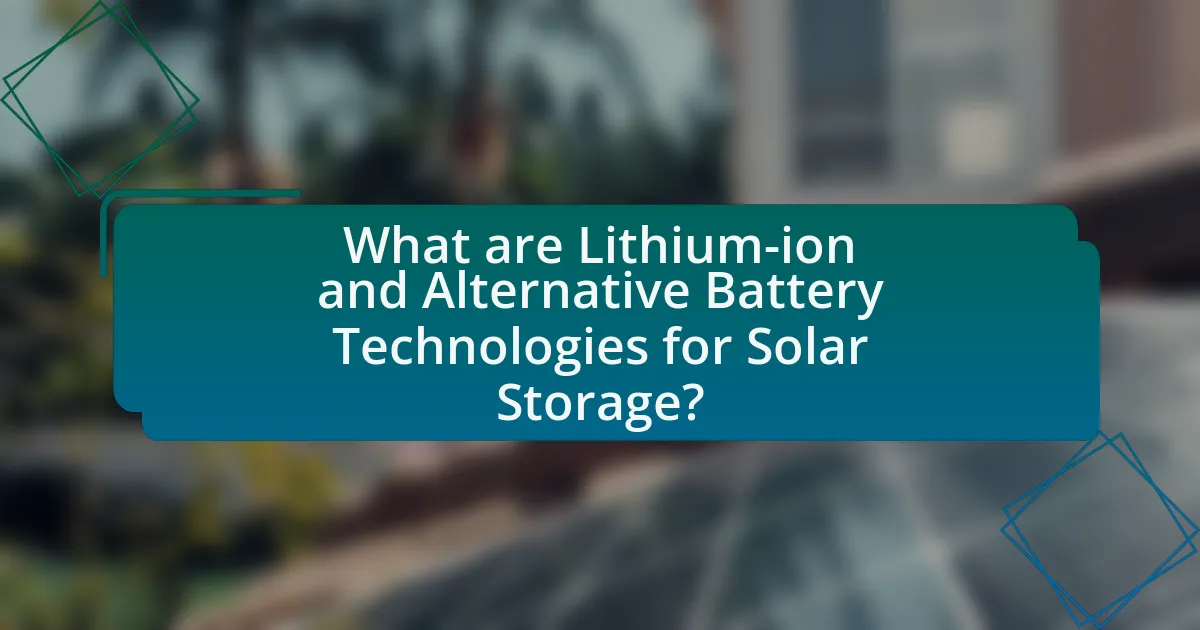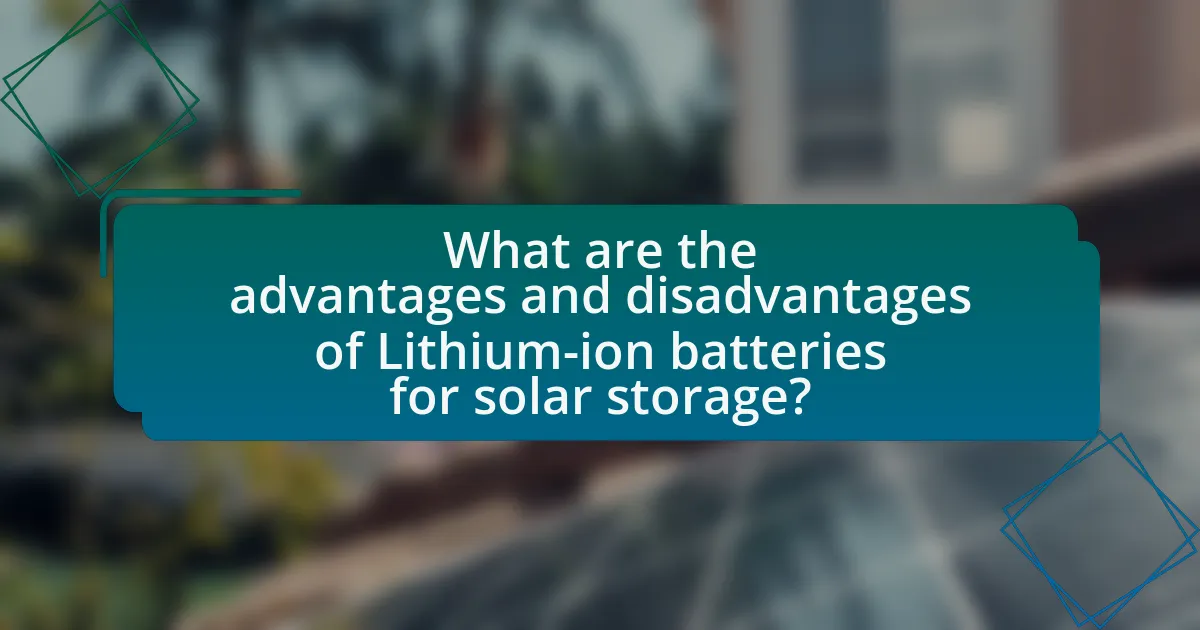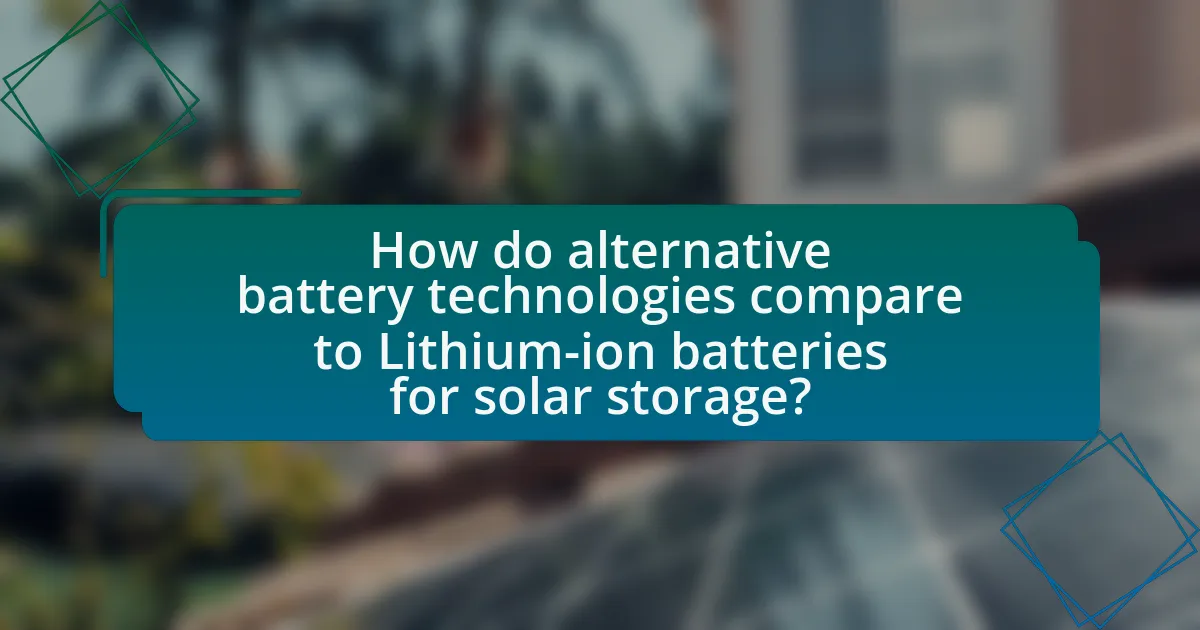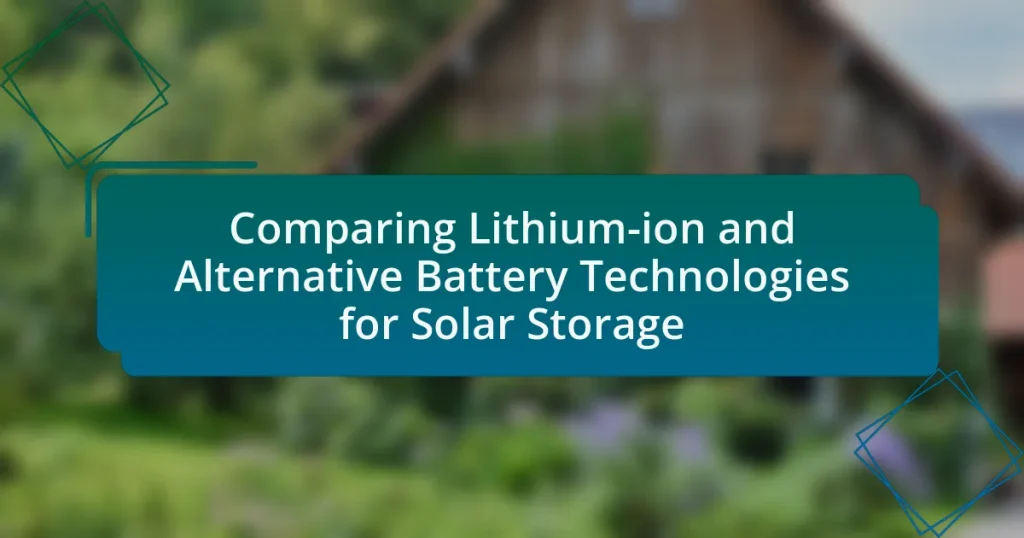The article focuses on comparing Lithium-ion and alternative battery technologies for solar storage, highlighting their functionalities, advantages, and limitations. It details how Lithium-ion batteries operate within solar systems, emphasizing their high energy density, efficiency, and longevity, while also discussing alternative options such as lead-acid, flow, and sodium-ion batteries. Key components, charging processes, and performance metrics of these technologies are examined, along with their environmental impacts and cost implications. The article aims to provide a comprehensive understanding of the various battery technologies available for solar energy storage, aiding users in making informed decisions based on their specific needs and applications.
What are Lithium-ion and Alternative Battery Technologies for Solar Storage?


Lithium-ion batteries are widely used for solar storage due to their high energy density, efficiency, and long cycle life, making them suitable for residential and commercial solar energy systems. In contrast, alternative battery technologies include lead-acid, flow batteries, and sodium-ion batteries, each offering distinct advantages and disadvantages. Lead-acid batteries are cost-effective but have a shorter lifespan and lower energy density compared to lithium-ion. Flow batteries provide scalability and longer discharge times, making them ideal for larger installations, while sodium-ion batteries are emerging as a promising alternative due to their abundance and lower environmental impact. The choice between these technologies depends on factors such as cost, application, and specific energy storage needs.
How do Lithium-ion batteries function in solar storage systems?
Lithium-ion batteries function in solar storage systems by storing excess energy generated from solar panels for later use. When solar panels produce more electricity than is needed for immediate consumption, the surplus energy is directed to charge the lithium-ion batteries. These batteries utilize electrochemical reactions to convert electrical energy into chemical energy during the charging process.
During discharge, the stored chemical energy is converted back into electrical energy, which can then be used to power homes or businesses when solar generation is insufficient, such as during nighttime or cloudy days. Lithium-ion batteries are favored in solar storage due to their high energy density, efficiency, and relatively long cycle life, which allows for numerous charge and discharge cycles without significant degradation.
What are the key components of Lithium-ion batteries?
The key components of Lithium-ion batteries are the anode, cathode, electrolyte, and separator. The anode is typically made of graphite, which allows for the intercalation of lithium ions during charging. The cathode is usually composed of lithium metal oxides, such as lithium cobalt oxide or lithium iron phosphate, which facilitate the release of lithium ions during discharge. The electrolyte, often a lithium salt dissolved in an organic solvent, enables the movement of lithium ions between the anode and cathode. Lastly, the separator is a porous membrane that prevents direct contact between the anode and cathode while allowing lithium ions to pass through. These components work together to enable the efficient storage and release of electrical energy in Lithium-ion batteries.
How does the charging and discharging process work in Lithium-ion batteries?
The charging process in Lithium-ion batteries involves the movement of lithium ions from the positive electrode (cathode) to the negative electrode (anode) through an electrolyte, while discharging reverses this flow. During charging, an external power source applies voltage, causing lithium ions to intercalate into the anode material, typically graphite, while electrons flow through the external circuit. This process stores energy in the battery. Conversely, during discharging, the lithium ions move back to the cathode, releasing energy that powers connected devices. This mechanism is efficient due to the reversible nature of the chemical reactions involved, allowing for high energy density and cycle stability, which are critical for applications like solar storage.
What alternative battery technologies are available for solar storage?
Alternative battery technologies available for solar storage include lead-acid batteries, flow batteries, sodium-ion batteries, and lithium iron phosphate (LiFePO4) batteries. Lead-acid batteries are widely used due to their low cost and established technology, although they have a shorter lifespan and lower energy density compared to lithium-ion. Flow batteries, such as vanadium redox flow batteries, offer scalability and long cycle life, making them suitable for large-scale energy storage. Sodium-ion batteries are emerging as a promising alternative, utilizing abundant materials and potentially lower costs, while lithium iron phosphate batteries provide enhanced safety and thermal stability compared to traditional lithium-ion batteries. These alternatives are being explored to address the limitations of lithium-ion technology in solar energy applications.
What are the main types of alternative battery technologies?
The main types of alternative battery technologies include solid-state batteries, flow batteries, lithium-sulfur batteries, and sodium-ion batteries. Solid-state batteries utilize a solid electrolyte instead of a liquid one, enhancing safety and energy density. Flow batteries store energy in liquid electrolytes, allowing for scalable energy storage solutions. Lithium-sulfur batteries offer a higher theoretical energy density compared to traditional lithium-ion batteries, potentially leading to lighter and more efficient energy storage. Sodium-ion batteries, using abundant sodium resources, present a cost-effective alternative to lithium-ion technology. These alternative technologies are being researched and developed to address limitations in energy density, cost, and sustainability associated with conventional lithium-ion batteries.
How do these alternative technologies compare to Lithium-ion batteries?
Alternative technologies, such as solid-state batteries, flow batteries, and sodium-ion batteries, generally offer advantages and disadvantages compared to Lithium-ion batteries. Solid-state batteries provide higher energy density and improved safety due to the absence of flammable liquid electrolytes, while flow batteries excel in scalability and longevity, making them suitable for large-scale energy storage. Sodium-ion batteries, on the other hand, utilize abundant materials, potentially lowering costs and reducing reliance on lithium resources. However, Lithium-ion batteries currently dominate the market due to their established technology, higher energy efficiency, and extensive infrastructure.
What are the advantages and disadvantages of Lithium-ion batteries for solar storage?


Lithium-ion batteries offer several advantages for solar storage, including high energy density, longer lifespan, and faster charging times. Their energy density allows for more energy to be stored in a smaller space, making them ideal for residential and commercial solar applications. Additionally, lithium-ion batteries typically have a lifespan of 10 to 15 years, which is longer than many alternative battery technologies, reducing the need for frequent replacements. They also charge more quickly, enabling efficient energy use during peak solar production times.
However, lithium-ion batteries also have disadvantages, such as higher costs and environmental concerns related to mining and disposal. The initial investment for lithium-ion systems can be significantly higher than for other battery types, which may deter some users. Furthermore, the extraction of lithium can lead to environmental degradation, and the recycling process for these batteries is not yet fully developed, raising concerns about their long-term sustainability.
What benefits do Lithium-ion batteries provide for solar energy systems?
Lithium-ion batteries provide several key benefits for solar energy systems, including high energy density, efficiency, and longevity. Their high energy density allows for more energy storage in a smaller footprint, making them ideal for residential and commercial solar applications. Additionally, lithium-ion batteries typically have a round-trip efficiency of around 90-95%, meaning that a significant portion of the stored energy can be effectively used, which maximizes the utility of solar energy. Furthermore, these batteries have a longer lifespan, often exceeding 10 years, which reduces the frequency of replacements and overall costs over time. These advantages make lithium-ion batteries a preferred choice for enhancing the performance and reliability of solar energy systems.
How do Lithium-ion batteries enhance energy efficiency?
Lithium-ion batteries enhance energy efficiency by providing higher energy density and lower self-discharge rates compared to alternative battery technologies. This means they can store more energy in a smaller volume and lose less energy when not in use. For instance, lithium-ion batteries typically have an energy density of about 150-200 Wh/kg, significantly higher than lead-acid batteries, which average around 30-50 Wh/kg. Additionally, lithium-ion batteries have a self-discharge rate of approximately 2-5% per month, whereas lead-acid batteries can lose 10-15% of their charge in the same period. These characteristics allow for more efficient energy storage and utilization in solar applications, maximizing the effectiveness of solar energy systems.
What is the lifespan of Lithium-ion batteries in solar applications?
The lifespan of Lithium-ion batteries in solar applications typically ranges from 10 to 15 years. This duration is influenced by factors such as charge cycles, temperature, and depth of discharge. Studies indicate that Lithium-ion batteries can retain about 70-80% of their original capacity after this period, making them a reliable choice for solar energy storage.
What are the limitations of Lithium-ion batteries in solar storage?
Lithium-ion batteries have several limitations in solar storage, including high cost, limited cycle life, temperature sensitivity, and environmental concerns. The high cost of lithium-ion batteries can make solar energy systems less economically viable, as they represent a significant portion of the overall investment. Additionally, these batteries typically have a cycle life of around 500 to 2,000 cycles, which can lead to reduced performance over time and necessitate replacement. Temperature sensitivity is another limitation, as lithium-ion batteries can degrade in extreme heat or cold, affecting their efficiency and lifespan. Finally, the extraction and disposal of lithium and other materials used in these batteries raise environmental concerns, particularly regarding resource depletion and pollution.
What safety concerns are associated with Lithium-ion batteries?
Lithium-ion batteries pose several safety concerns, primarily including the risk of thermal runaway, which can lead to fires or explosions. This phenomenon occurs when the battery overheats, often due to internal short circuits, manufacturing defects, or external damage. According to a study published in the Journal of Power Sources, thermal runaway can result in temperatures exceeding 1000 degrees Celsius, significantly increasing the risk of combustion. Additionally, lithium-ion batteries can experience electrolyte leakage, which may cause chemical burns or environmental hazards. The National Fire Protection Association has reported incidents where improper handling or charging of lithium-ion batteries has led to fires, underscoring the importance of adhering to safety guidelines during use and storage.
How do costs compare with alternative battery technologies?
Costs for lithium-ion batteries are generally lower than those of alternative battery technologies, such as lead-acid and flow batteries. For instance, as of 2023, the average cost of lithium-ion batteries is approximately $150 per kilowatt-hour, while lead-acid batteries can range from $200 to $300 per kilowatt-hour. Flow batteries, on the other hand, can exceed $500 per kilowatt-hour. This cost advantage for lithium-ion batteries is primarily due to advancements in manufacturing processes and economies of scale, which have significantly reduced production costs over the past decade.
How do alternative battery technologies compare to Lithium-ion batteries for solar storage?


Alternative battery technologies generally offer different advantages and disadvantages compared to Lithium-ion batteries for solar storage. For instance, flow batteries provide longer cycle life and scalability, making them suitable for large-scale energy storage, while Lithium-ion batteries excel in energy density and efficiency, which is beneficial for residential applications. Additionally, sodium-ion batteries are emerging as a cost-effective alternative with lower environmental impact, although they currently lag in energy density compared to Lithium-ion. Research indicates that while Lithium-ion batteries dominate the market due to their established technology and performance, alternative technologies like solid-state batteries and lithium-sulfur batteries are being developed to address limitations such as safety and resource scarcity.
What are the key performance metrics for alternative battery technologies?
The key performance metrics for alternative battery technologies include energy density, cycle life, charge/discharge rates, efficiency, safety, and cost. Energy density measures the amount of energy stored per unit weight or volume, which is crucial for applications requiring lightweight solutions. Cycle life indicates the number of charge and discharge cycles a battery can undergo before its capacity significantly degrades, impacting longevity and usability. Charge/discharge rates reflect how quickly a battery can be charged or discharged, affecting performance in real-time applications. Efficiency assesses the ratio of energy output to energy input, influencing overall energy management. Safety metrics evaluate the risk of failure or hazards, such as thermal runaway, which is critical for user acceptance. Lastly, cost metrics determine the economic feasibility of the technology, including initial investment and lifecycle costs. These metrics are essential for comparing alternative battery technologies against lithium-ion batteries in solar storage applications.
How do energy density and efficiency compare with Lithium-ion batteries?
Energy density and efficiency of alternative battery technologies generally differ from those of Lithium-ion batteries. Lithium-ion batteries typically have an energy density of about 150-250 Wh/kg and an efficiency of around 90-95%. In comparison, technologies like solid-state batteries can achieve higher energy densities, potentially exceeding 300 Wh/kg, while maintaining similar efficiency levels. Other alternatives, such as flow batteries, may have lower energy densities (20-40 Wh/kg) but can offer longer cycle life and scalability, which can be advantageous for solar storage applications. These comparisons highlight the varying strengths and weaknesses of different battery technologies in relation to Lithium-ion batteries.
What is the environmental impact of alternative battery technologies?
Alternative battery technologies, such as sodium-ion, solid-state, and flow batteries, generally have a lower environmental impact compared to traditional lithium-ion batteries. These alternatives often utilize more abundant and less toxic materials, reducing the ecological footprint associated with mining and processing. For instance, sodium-ion batteries use sodium, which is widely available and less harmful to extract than lithium. Additionally, solid-state batteries promise improved safety and longevity, potentially decreasing waste and the frequency of replacements. Research indicates that flow batteries can be recycled more efficiently, minimizing landfill contributions. Overall, the shift towards these technologies can lead to reduced resource depletion and lower greenhouse gas emissions throughout their lifecycle.
What are the cost implications of using alternative battery technologies?
The cost implications of using alternative battery technologies include generally lower initial costs but potentially higher lifecycle costs compared to lithium-ion batteries. For instance, technologies such as flow batteries and sodium-ion batteries may have lower upfront capital expenditures, making them attractive for initial investment. However, their efficiency, energy density, and longevity can lead to higher operational costs over time. Research indicates that while flow batteries can be cheaper to install, their lower energy density results in larger physical systems, which can increase installation and maintenance costs. Additionally, sodium-ion batteries, while promising in terms of material availability and cost, currently face challenges in energy density and cycle life, which can affect their overall economic viability in long-term applications.
How do installation and maintenance costs compare to Lithium-ion batteries?
Installation and maintenance costs for alternative battery technologies, such as lead-acid batteries, are generally lower than those for Lithium-ion batteries. Specifically, lead-acid batteries can have installation costs that are approximately 30-50% less than Lithium-ion systems, primarily due to simpler installation requirements. However, maintenance costs for lead-acid batteries can be higher over time, as they require regular maintenance, including electrolyte checks and potential replacement of components, which can add up to 20-30% more than the maintenance costs associated with Lithium-ion batteries, which are typically low due to their sealed design and minimal upkeep needs. Thus, while initial installation may be cheaper for alternatives, long-term maintenance can offset those savings.
What are the long-term financial benefits of alternative battery technologies?
Alternative battery technologies offer significant long-term financial benefits, primarily through reduced costs, increased lifespan, and enhanced efficiency. For instance, technologies such as solid-state batteries and flow batteries can provide longer cycle lives, often exceeding 10,000 cycles compared to lithium-ion batteries, which typically last around 2,000 to 3,000 cycles. This longevity translates to lower replacement costs over time. Additionally, alternative batteries often utilize more abundant and less expensive materials, which can lead to lower production costs and reduced price volatility. According to a report by the International Energy Agency, transitioning to alternative battery technologies could reduce energy storage costs by up to 50% by 2030, making them a financially attractive option for solar storage solutions.
What practical considerations should be taken into account when choosing a battery technology for solar storage?
When choosing a battery technology for solar storage, practical considerations include energy density, cycle life, cost, safety, and environmental impact. Energy density determines how much energy can be stored in a given volume, which affects the size and weight of the battery system. Cycle life indicates how many charge and discharge cycles the battery can undergo before its capacity significantly degrades, influencing long-term performance and replacement frequency. Cost is a critical factor, encompassing both initial investment and ongoing maintenance expenses, which can vary widely among different technologies. Safety concerns, such as the risk of thermal runaway in lithium-ion batteries, must also be evaluated to ensure user protection. Lastly, the environmental impact of battery production and disposal, including resource extraction and recycling capabilities, is increasingly important in sustainable energy solutions. These considerations collectively guide the selection of the most suitable battery technology for effective solar energy storage.
How can users determine the best battery technology for their specific needs?
Users can determine the best battery technology for their specific needs by evaluating factors such as energy density, cycle life, cost, and application requirements. Energy density indicates how much energy a battery can store relative to its size, which is crucial for space-constrained applications. Cycle life refers to the number of charge and discharge cycles a battery can undergo before its capacity significantly diminishes; for example, lithium-ion batteries typically offer 500 to 2,000 cycles, while lead-acid batteries may only provide 200 to 300 cycles. Cost considerations include both initial investment and long-term maintenance expenses, as lithium-ion batteries tend to have a higher upfront cost but lower total cost of ownership over time. Additionally, users should assess their specific application needs, such as whether they require fast charging, deep cycling, or temperature tolerance, to select the most suitable technology.
What are the common troubleshooting tips for both Lithium-ion and alternative battery technologies?
Common troubleshooting tips for both Lithium-ion and alternative battery technologies include checking for proper connections, ensuring the battery is charged to the appropriate level, and monitoring for temperature extremes. Proper connections are crucial as loose or corroded terminals can lead to performance issues. Maintaining the correct charge level is essential since both types of batteries can suffer from reduced lifespan or efficiency if consistently undercharged or overcharged. Additionally, temperature extremes can affect battery performance; for instance, Lithium-ion batteries typically operate best between 20°C and 25°C, while alternative technologies may have different optimal ranges. Regularly inspecting these factors can help mitigate common issues and enhance battery longevity.


